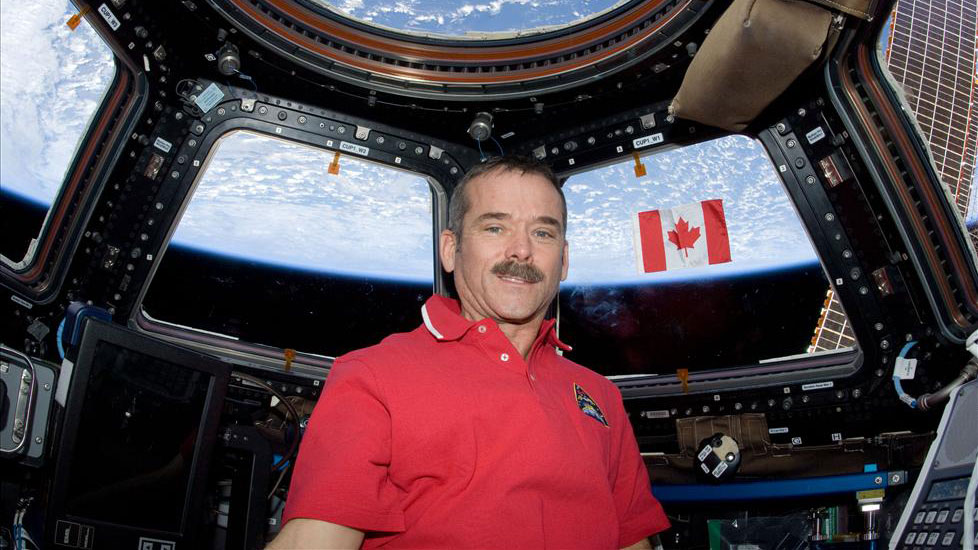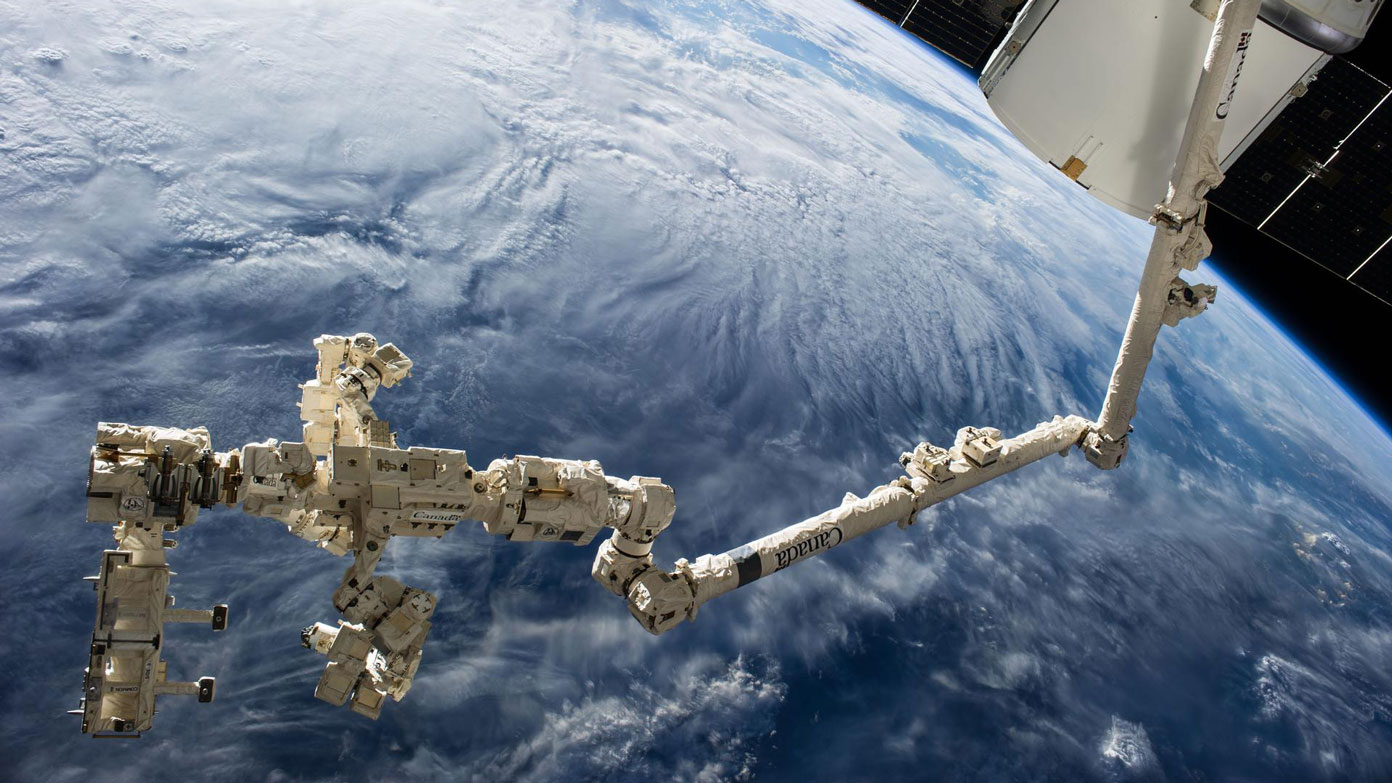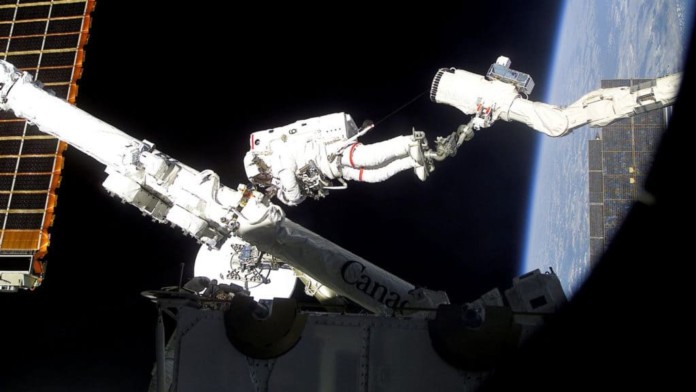There are good reasons why the Canadarm is on the back of the Canadian five dollar bill. According to retired Canadian astronaut Col. Chris Hadfield, the Canadarm was our ticket to space exploration. This series of robotic arms flew with the space shuttles, and the newest model is a permanent fixture on the International Space Station (ISS). And it is one of Canada’s most celebrated and iconic technological advances.
In honour of Canada’s 150th birthday, we caught up with Col. Hadfield (the first Canadian to walk in space, and the first to operate both Canadarms!) and we’re celebrating with a list of some of our favourite Canadarm moments and achievements.
 Astronaut Chris Hadfield hanging out with a Canadian flag at the International Space Station.
Astronaut Chris Hadfield hanging out with a Canadian flag at the International Space Station.
Credit: NASA.
Without Canadarm, there would be no Canadian astronauts
Canadian spaceflight was launched by Canadian robotics.
“Canadarm was really our ticket on board, and that allowed Canada to be part of the space program,” says Hadfield. “If there had been no Canadarm, there would have been no Canadian astronauts. Having the agreement between Canada and NASA allowed our first class of astronauts to be hired.”
Not only that, Canadian astronauts continue to be important members of the space exploration community, not just as passengers, but as active participants, says Hadfield. We continue to bring important research on board.
Canadarm built the International Space Station, and more
The original Canadarm was actually produced as a series of five, which flew with the space shuttles (one of them is back and on display at the Canadian Aviation and Space Museum). During their lifetime, they helped deploy and build some of the most famous space exploration tools.
In 1990, Canadarm was used to release the Hubble Space Telescope, and later to retrieve it when it needed repairs. Canadarm can reach out and pluck objects straight out of free-floating space!
 A household name, the Hubble Space Telescope would not have been possible without the Canadarm. And without the Hubble Space Telescope, we would be missing out on a huge library of images like this one of the Omega Nebula.
A household name, the Hubble Space Telescope would not have been possible without the Canadarm. And without the Hubble Space Telescope, we would be missing out on a huge library of images like this one of the Omega Nebula.
Credit: NASA.
On Hadfield’s first spaceflight in 1995, he operated one to build a five-tonne docking station on the Russian space station Mir. An international bridge, it served as the physical link between Mir and the American space shuttle.
All of this led to the design of a next-generation Canadarm, the Canadarm2. Much more advanced and capable, Hadfield describes it as a natural extension of the operator: so well designed that it hardly feels like operating a machine.
Accelerated video footage of the first time astronaut Chris Hadfield operated Canadarm2.
Credit: Canadian Space Agency.
And in an incredible story of Canadian and international achievement, Canadarm and Canadarm2 worked together to build the ISS. Canadarm2 assembled the entire space station piece by piece, each of which was handed to it by a first-generation Canadarm.
Canadarm2 is now permanently attached to the ISS, and has been since spring 2001.
Canadarm2 can walk around the Space Station like an inchworm
Unlike the original Canadarm, which was permanently mounted in one place on the space shuttle it flew with, Canadarm2 is mobile; detachable at both ends, it can flip itself end over end to “walk” freely all over the ISS like an inchworm.
Or at least a really big inchworm.
“Canadarm2 is immense, it’s the size of a sequoia,” says Hadfield. “It can grab the entire space shuttle and wave it around, a quarter of a million pound vehicle, and yet it’s exquisitely precise.”
These features help it build, repair, and inspect the ISS, all while gently snapping up moving objects and carrying out various robotics experiments.
Canadarm has only grown in capability, both in orbit and on the ground
Not just a tool routinely used by astronauts, Canadarm2 also can be remotely operated by engineers on the ground in Montreal. This remote access allows ground crews to perform tasks while the crew rests or carries out other duties.
“As a result of the two Canadarms, we have for a generation been the world leader in space robotics,” explains Hadfield. “Not just in design and building, but in operations, how to overcome problems, how to build and maintain the hardware as it gets old.”
And as Canada develops even better technology, new parts continue to be installed, including Dextre, a sophisticated robotic hand. The handyman of the ISS, Dextre can be used independently, or attached to Canadarm2.
 Dextre, also known as the Canada Hand, represents the most advanced space robotics to date. The handyman of the ISS, it can be used on the end of Canadarm2, as shown, or independently.
Dextre, also known as the Canada Hand, represents the most advanced space robotics to date. The handyman of the ISS, it can be used on the end of Canadarm2, as shown, or independently.
Credit: NASA.
This robust suite of robotics is also making its way back to Earth in many applications, including a sensitive and precise robotic arm for children’s surgeries.
Aside from the moon, the Space Station is the brightest object in the night sky
If you’re looking for a reminder of some of humanity’s greatest science moments, the sky is a great place to look. The ISS is clearly visible from anywhere on the planet, as long as it’s passing by at the right time.
NASA’s Spot the Station tool can send you an alert for the best times to spot the ISS from your city, or just take a look at dusk or at dawn to try your luck. At those times, the sky is dark, but the sun is on the same side of the Earth and more readily illuminates the Station’s metal structures.
“The beauty is that anyone in the world can do this,” says Hadfield. “They can look at the sky at dusk or at dawn, and if it’s passing by on a clear night, they’ll be able to see it. It’s the third brightest object in the sky after the sun and the moon, and it’s a shining beacon of what can be achieved when nations work together.”








































